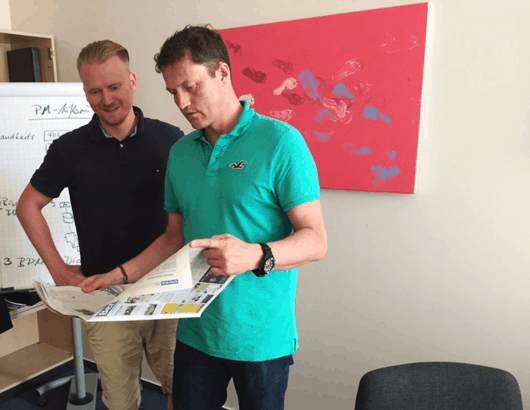Signavio Visits the Free Ads Paper "Berliner Woche"
We believe that Business Process Management (BPM) and Business Decision Management (BDM) can make any organization more efficient. However, this doesn’t just happen overnight, employees may not necessarily be delighted when management decides to implement a BPM initiative and there are challenges. How do organizations overcome challenges they are faced with in day-to-day Process Management? How can they use it to better achieve their aims? What is it that actually motivates organizations to implement BPM/BDM in the first place? At Signavio we keep our eyes and ears open on your behalf, regularly talking to our customers, gaining helpful insights and knowledge from their experience and sharing it in our published interviews.
Most recently, we chatted to Bodo Krause, publishing director of the free ads paper "Berliner Woche", about how the print publisher is approaching Process Management. Find out what he had to say below, do these challenges sound all too familiar?
To read this interview in German, click here
Mr Krause, tell us a bit about your organization. How is Berliner Woche structured? Which forms of media do you publish? What are the challenges you face?
Berliner Woche is an advertizing paper and belongs to the Funke Medien Group, the biggest publisher of advertizing papers in Germany. We produce and publish 33 fully regionalized issues per week with a total circulation of around 1.5 million. Our biggest challenge is definitely our massive production volume: we produce up to 1000 pages per week which pass through the hands of process stakeholders in minutes - from editors to producers. Nonetheless we expect quality levels to remain consistently high. As a result it’s important for us to organize our work on the basis of optimized processes.
That sounds pretty hectic! Was that the reason you decided to take a closer look at your processes?
In the beginning our goal was to simply to create a process handbook. We wanted to document the procedures we had and how they work so we could optimize them.
When did your Process Management initiative begin?
Due to production requirements, we were always conscious of the significance of work processes. A few years ago we began to take a structured approach to documenting our processes, collecting the data in Excel and Visio with the help of a consultant. The result was informative and in parts extremely detailed. This in turn had the potential to prevent us from “seeing the woods for the trees” and was not conducive to our employees identifying with the idea of structured process analysis.
Knowing your own processes is pretty crucial in most cases. Did you also have concrete targets that you wanted to reach with your project?
Our main concern is the continuous optimization of our processes. This includes analyzing ‘as-is’ processes as well as creating requirements for their restructuring. Transparency is the most important element for us. That means we expect a Process Management System to make the process organization of the company as clear and comprehensible for as many employees as possible.
What do you expect to improve?
Firstly, the ability to recognize weak points in existing processes. This implies knowing your current state processes, having an awareness of appropriate benchmarks as well as an idea of an optimal or improved approach.
Additionally it requires a willingness to standardize in line with a process which has been assessed as optimal - or at least better. This is a pretty sensitive subject for publishing houses, at the end of the day, we’re producing creative content not standard sized screws. Finding the right balance without going overboard is a significant prerequisite to the acceptance of Process Management by media professionals.
Ultimately the complete process structure must be regularly tested and re-assessed. After process optimization comes the next improvement. Through this we are developing a fundamentally agile attitude, which reveals the full benefits of Process Management.
How did you approach the documentation of your processes?
On the first attempt, we followed a bottom-up principle - starting with the desired process and moving onto the next one, until eventually everything was documented. That was a mistake because parts of the process landscape were far too detailed and others not detailed enough. For that reason, today we only model processes in a top-down fashion.
Are there currently also specific figures that you’re measuring?
Yes, we have begun with documenting processes so that we would know them. Now we’re into another phase, in which the measuring of KPIs is moving into the foreground. This is pretty new for us actually.
That means, until now you haven’t established any key figures, which you could measure on a regular basis?
Sure! There are figures that positively jump out at you, but there are others that you have to dig deeper for. Of course, we’re specifically targeting KPIs with which we can steer the company. For example, we’re levying detailed delivery rates throughout our total area of circulation. With these measurements we are achieving top results and can really differentiate ourselves from other publishers.
You can achieve all this with Signavio?
No, at the moment not everything is happening in Signavio. Modeling is the main focus there, to make processes transparent. Documenting KPIs directly in Signavio only makes sense in the context of process automation. At the moment we’re testing which processes this could be possible for.
Time pressure, Publishing crises… What is the feeling towards Process Management in your organization? Are your employees in favour of it?
In some cases, BPM is quickly understood as a helpful tool and accepted openly. Some departments that involve logistics or production have already been using Process Management methods for years.
In other departments, the subject of BPM has been adopted in a more cautious way. Some employees possibly feel patronized and don’t consider Process Management to be an appropriate solution in the creative sector.
How did you manage to make Process Management stick?
Generally, we work in tandem. A specialist with detailed process knowledge, works with a method expert on the current state processes. The method expert takes over the documentation. We’ve had great experiences through this with the students of BPM background, who work for us part time.
After documentation, what happens with the models?
They continue to be used as references, for example for coordination across different locations. When I call a colleague at a different location, with Signavio the communication is straightforward. You can invite them to Signavio and then both of you can look at the same processes together on two different screens. The BPMN diagrams are mostly understandable straight away, you can make comments and improvement suggestions in the dialogue box without losing an overview of what’s happening with the process. This level of quality is not possible with Visio graphics, neither technically nor semantically.
It sounds as though the acceptance for Process Management through professional software has grown rapidly!
It’s sadly not that simple, we have only scratched the surface. Although the benefits are clearly recognizable and visible in several areas, the willingness to engage with the subject isn’t evenly pronounced amongst all departments.
Are the departments getting involved?
Yes, due to the fact that all processes are documented in the collaboration portal. If you want to change something in a process, the first step is always to see if it has been documented. We’re sure that this top-down approach is bringing about sustainable improvement. Through this approach, we’re bringing all departments together. At the beginning, in every part of the organization, department and method experts get together and model a process landscape. In doing this, employees have a direct influence on the process architecture and unnecessary processes are ascertained. The basic principle is that a process is only documented when there is a clear BPM use.
So you stand by the motto, “Keep it short and simple”?
For us, there’s a significant subsidiary thought which is pretty much always applicable to management: We always ask ourselves the question “What would happen if I didn’t control this process with BPM?” In some cases, the answer is “Nothing!” Not everything is a process and sometimes less is more. That’s something we learnt in our BPM initiative.
What are your next steps?
We will test the documented processes for their automation potential. As part of that we are also planning a test with Signavio Workflow.
In any case, we need a more heightened awareness of processes. Up until this point there has sadly been no sustainable analysis into the impact of Process Management on the publishing sector. Due to that, it’s hard to put a figure on the benefits. The challenge is to make the value of BPM visible as soon as possible.
Would you say say that you were able to reach the goals you had envisioned?
Technically speaking, we’ve definitely reached our goal of setting up a process handbook. Process Management is more of an attitude than a project. You could quote Confucius in saying that the journey is the destination, and we’ve only just begun to walk the path.
Would you choose to do anything differently with hindsight?
Two things in particular:
- I would start with a top-down approach straight away.
- I would work towards an iterative approach much earlier which, beside documentation, targets communication with stakeholders.
Would you have a piece of advice that you’d like to give to our readers about Business Process Management?
Two which I’ve already named; “Less is more” and “the journey is the destination”. You might even be able to add, “He who writes, succeeds”.
Could you describe Signavio in a few words?
- A successful spin-off.
- A start-up in the most positive sense of the word.
We thought we’d surpassed the start-up phase with more than a 100 employees.
(laughing) I mean more, the start-up mentality which you’re keeping alive! I enjoy working with Signavio because this freshness enriches old economy organizations like ours.
Sounds good! We have to admit, we did take our football table with us to the new office, some things never change!
You’ve moved again? Time for me to call round for a visit I guess!
- To find further inspiration for your own project visit our download center
- If you want to try Signavio, just register for our 30-day free trial
This interview was recorded on the 24.06.2016 in Berlin. Thank you for the nice conversation!


